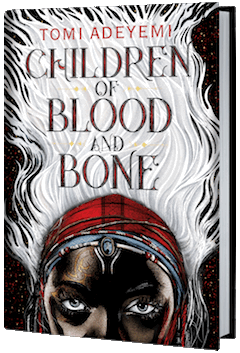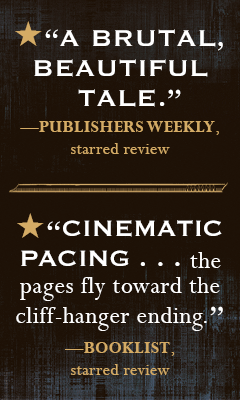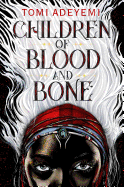Children of Blood and Bone (Legacy of Orïsha)
by Tomi Adeyemi
Eleven years ago, six-year-old Zélie Adebola watched as her mother, a powerful maji, was hanged from a tree in a brutal raid led by a monarchy that feared and despised magic. That day, as the monarchy tortured and killed any maji they could find, magic disappeared. Now Zélie and other divîners--children of the fallen maji who should have come into their powers at age 13--secretly train to defend themselves and others against the soldiers of King Saran. As their trainer, Mama Agba, tells them, "Though your ability to become maji has disappeared, the hatred and violence toward you remains."
Divîners are recognizable by their white hair, contrasting sharply with their own brown skin, and with the brown hair and skin of those around them. "In the beginning," Zélie's mother used to tell her, "white hair was a sign of the powers of heaven and earth. It held beauty and virtue and love, it meant we were blessed by the gods above. But when everything changed, magic became a thing to loathe. Our heritage transformed into a thing to hate." The "maggots," as the king's guards call divîners, are taxed relentlessly for their very existence.
Now 17, fiery, impulsive Zélie is eager to compete in her graduation staff-fighting match. She has no idea just how soon her training will be put to real use and that she will soon long for the days when taxation was her biggest concern. The first of many dramatic chains of events brings Zélie and her brother, Tzain--a kosidán, or citizen of Orïshan who doesn't have the potential to do magic--to Lagose, the seat of the monarchy.
Meanwhile, in the royal palace, King Saran's daughter, Amari, is beginning to question her father's methods for keeping the "maggots" in their place. When he commits an unforgivable act against her beloved chambermaid/friend, a divîner, Amari is compelled to act--and escape. Soon she, Zélie and Tzain, astride Zélie's "lionaire" Nailah (a massive lion-like creature with horns) are running for their lives. In hot pursuit are soldiers led by Amari's brother Inan, the crown prince.
So begins this epic tale of maji and kings, swaying allegiances, cultural quandaries, deep prejudices and forbidden love. Based in a fictionalized West Africa, Children of Blood and Bone borrows heavily and gracefully from the culture and language of the region. Every character is a shade of brown: "soft copper," "coconut," "dark chestnut," "mahogany," "oak," "obsidian," although the nobility pride themselves on their paler skin, and some go to painful measures to lighten their complexion.
Told in the alternating voices of Zélie, Amari and Inan, this first book in a trilogy by Nigerian American debut author Tomi Adeyemi delves into fantasy world themes paralleling real-world issues: racism and classism, blended families, war and the messy, ambiguous line between good and evil. Each character is deeply conflicted by her or his respective obligations and expectations in a way that readers absolutely will relate to, even if magic is not the underlying source of their own conflict. Zélie longs to avenge her mother's death but struggles with her impulsivity and recklessness: "I can't even sell a fish without causing the destruction of my entire village. How am I supposed to be the maji's only hope?" Amari has spent her privileged royal life being told to fear magic, but when she sees it for the first time, she's overcome with awe: "How can something so beautiful truly be evil?" Inan, too, has been told by their father, the king, that magic is the source of all evil, the root of all their pain. His father believes that if maji are allowed to practice, this magic will tear their world apart. As next in line to the throne, Inan grapples with the mantra that has been drilled into him since birth: "Duty before self." Now, though, Inan is discovering, as they all are, that the folklore and beliefs of their families and culture may not be as clear-cut as they have always been told. Bewildering questions blast through all their minds: What if magic and monarchy could come together? Does magic have the power to solve the world's problems? Why is one side's shattering violence any more or less justifiable than the other's?
Balancing wit and intensity, Adeyemi's cinematic writing will strike a chord with teen readers. In one thrilling scene worthy of a Harrison Ford movie, guards are closing in on Zélie and Amari, blocking all their escape routes. Zélie prepares to die--until Nailah's "monstrous figure" leaps into the fray: "Guards tumble back in fear as my lionaire lands on the dirt path, saliva dripping from her massive fangs. I'm convinced she's a hallucination until I hear Tzain shouting from atop Nailah's back.
" 'The hell you waiting for?' he yells. 'Get on!' "
In a novel positively dripping with imagery and story, Adeyemi builds a world no reader is soon to forget, drawing on folklore and language from Yoruba, West Africa, as well as the traditions of fantasy. When the last remaining liaison between maji and the gods, known as a sêntaro, tells Zélie, Amari and Tzain the creation story, he describes the 10 deities linked to each of the 10 clans: "In the beginning, our Sky Mother created the heavens and the earth, bringing life to the vast darkness.... On earth, Nana Buruku created humans, her children of blood and bone. In the heavens Nana gave birth to the gods and goddesses."
Just so, Tomi Adeyemi has given birth to a fantasy of remarkable proportions. --Emilie Coulter









